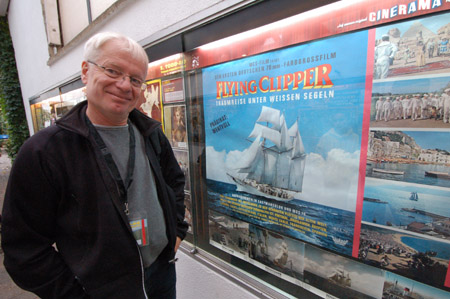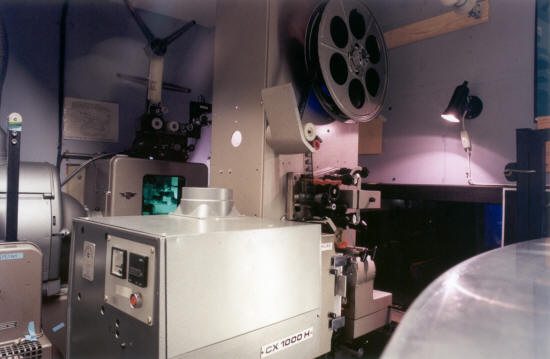The Biggest Format, in the Smallest Cinema |
This article first appeared in |
||||||||||||||
| Written by: Thomas Hauerslev | Issue 55 - December 1998 | ||||||||||||||
 Orla
Nielsen in Karlsruhe 2. October 2009. Image by Thomas Hauerslev Orla
Nielsen in Karlsruhe 2. October 2009. Image by Thomas HauerslevIn this interview Danish cinematographer and 70mm cinema owner Mr. Orla Nielsen, DFF, gives your Editor his thoughts on why he is managing the smallest public cinema on the planet with a DTS 70mm installation and a curved screen. The interview was done on November 21st, 1998, after another performance of "Titanic" in DTS 70mm. The cinema "Biffen" is located in Aalborg, Denmark and has appeared before in The 70mm Newsletter. |
Further in 70mm reading: |
||||||||||||||
|
|
||||||||||||||
"I run 70mm at Biffen for the simple reason I think it is a fabulous format" |
|||||||||||||||
 Biffen.
Picture by Thomas Hauerslev. Biffen.
Picture by Thomas Hauerslev.We opened our Cinema café in May 1997 after getting our own entry door. For many years we shared the entrance with a concert venue. We have a few café tables, antique film equipment on the walls, and various other "old" things everywhere. Mahogany furniture, mirrors and glass shelves contain numerous film books. We got the furniture from an old sweet shop. The interior reminds me of my childhood cinema. It is a mixture of old and new. Old furniture and modern illumination. Just above the entrance to the cinema there is an old Arriflex 35mm camera and a reel of 70mm film. We have a small auditorium with 50 seats. There are very good sightlines to the screen from all seats. We have a curved screen made according to the plans for a CinemaScope curve, originally drawn up many years ago. The screen is 6,15 meters along the curve and 2,45 meters high. It is a bit larger than our previous screen built when we opened in 1989. It's a very nice screen. What we have tried to do with our cinema is to take all good parts, or the best things, from the large cinemas where we like to see films, and downscale them to our cinema. We have excellent sightlines and a large screen. Our screen isn't huge, but it does appear large to the spectator. You really get maximum impact here. We give the light on the screen much attention, and of course we have good sound. We have analogue optical and magnetic sound but also two digital formats; DTS and Dolby Digital. DTS even in 70mm! Our audiences appreciate our sound, and our good seats. They often tell us how good they are to sit in. They are soft and comfortable, of Spanish design and more than 10 years old. Originally they came from Nřrreport Bio in Copenhagen, after it closed in 1981. |
|||||||||||||||
 Biffen's
projection. Picture by Thomas Hauerslev. Biffen's
projection. Picture by Thomas Hauerslev.We have many good pieces of projection equipment in our booth. I am very impressed by the Dutch DP70 projector from Philips, and one is installed as our main projector. All performances are run on the DP70, both 70mm and 35mm. The DP70 is located dead-center, slightly above the center line. Every effort has been made to ensure a perfectly sharp picture. Secondly, we have a DP75 to run the commercials and trailers. It is also a very fine projector. We also have a 70mm/35mm 4-table non-rewind platter system which we built a few years ago when we needed to run several 70mm films on one machine. Originally we wanted to buy a Kinoton, but at a price of DKK 100.000 (USD $15.500), it was too expensive for us. The price has dropped since, I believe. Some of our projectionists at that time convinced me, however, we could build our own non-rewind for DKK 30.000, or DKK 35.000 if we were extravagant. It would not be a problem at all, they assured me. Anyway, they started working on it and they ran into many problems along the way and there were many delays. When it was finally finished, it ended up costing as a Kinoton, and it took us three years to pay for it. Not a very good solution, but that is life. We should have bought a Kinoton in the first place. The quality is very good though, and we rarely have problems with it. Our sound system is centered around a Dolby CP65 processor with 70mm Dolby-A noise reduction and a Dolby DA-20 digital sound unit. Last year we had a good offer from Nordisk Film in Copenhagen to buy DTS 70mm including installation. We thought we were going to show "Vertigo" in 70mm DTS. In the end UIP imported a 35mm version. Anyway, we have now shown our first 70mm DTS film; "Titanic" a year and a half later. We ought to run more of that. It is so easy to run, and looks and sounds excellent. No more problems with magnetic sound. Magnetic sound can be exceptionally good with a new print and all that, maybe even better than digital sound. |
|||||||||||||||
 Biffen's
logo / poster. Biffen's
logo / poster.I run 70mm at Biffen for the simple reason I think it is a fabulous format. I like to look at it, it is easy to handle and we can run it. It is a pleasure for me to see a large well-illuminated 70mm image on the screen. And with that large hole in the projector aperture plate, it is easy to punch some light onto the screen. Those are the primary reasons why I run 70mm here. Our CinemaScope picture looks good too, but there is something special about 70mm which is hard to describe. If you see a picture filmed in that format, it is beyond competition, like "Baraka". All those details, the definition and brilliance, it is unbelievable. It is like looking out of a huge window. It is almost three-dimensional. Our audience is very happy to see 70mm. There is a large faithful crowd coming back every time we show 70mm. And especially "Baraka". I think we have shown it more than 85 times, which is a record here at Biffen. We are running it again in two weeks time, and 83 tickets are already booked. We have also shown "2OO1: A Space Odyssey" in 70mm many times, and "Spartacus" once which was seen by many people. And finally we have shown "Far and Away". The audience prefers for our cinema and the equipment to be in fully working order, and they like to have a chat with us before or after the film. We are there every evening and quite often they address us. If they are technically interested, we invite them to the projection room for a chat. A typical complaint in cinemas is a picture out of focus. It can happen here too of course, but I do make an effort to tell our projectionists to focus. If they can't, they are asked to get glasses or find a new job. Above all, it must be nice to work here, but a well-focused picture is essential here. We have a guest book, and when the audiences time after time write how happy they are with our techniques and presentations, well, that makes us happy. |
|||||||||||||||
|
Go: back
- top - back issues Updated 22-01-25 |
